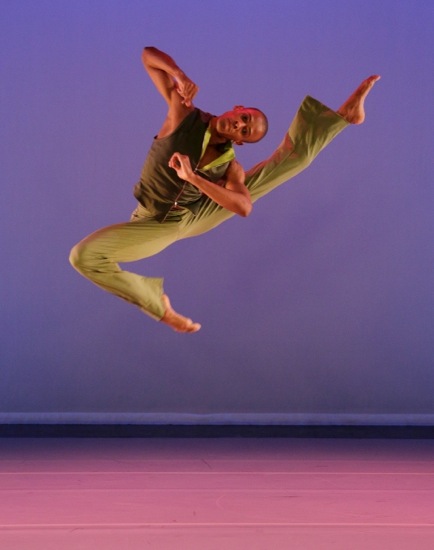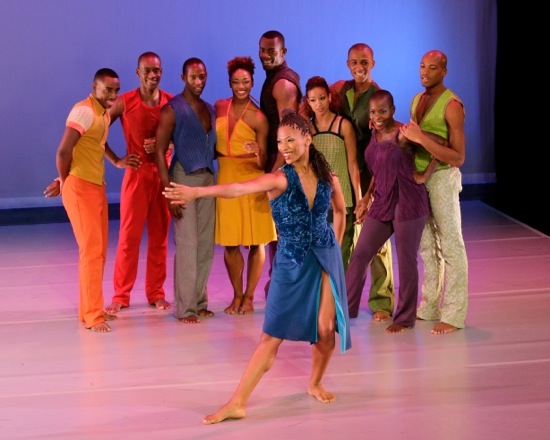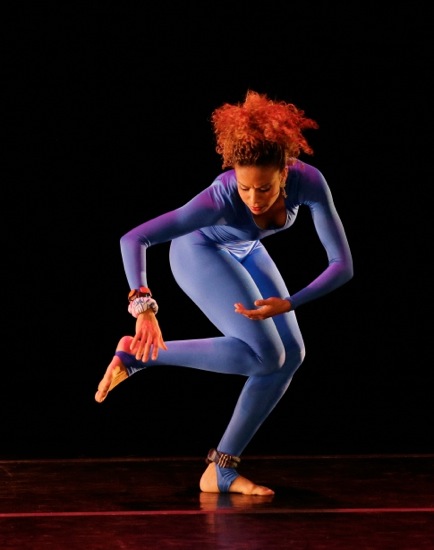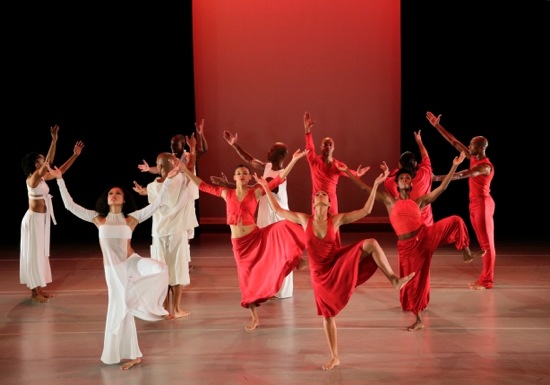
Yannick LeBrun of the Alvin Ailey American Dance Theater in Kyle Abraham’s Another Story. Photo: Paul Kolnik
Imagine a night at City Center watching the Alvin Ailey American Dance Theater when the spectators cheer at the curtain calls and applaud certain stunning dancers or sections of a dance, but don’t whoop and holler in the middle of a serious (even reverent) passage. Imagine an evening in which electric high jumps, long balances, and legs kicking the sky are worked into the choreographic fabric and not presented with an eye for our approval.
The night I’m talking about is one that displayed a world premiere by the extremely up-and-coming Kyle Abraham, the company debuts of Garth Fagan’s 1979 From Before and Robert Battle’s 1998 Strange Humors, and Ronald K. Brown’s Grace, which the company premiered in 1999.
The Ailey dancers are so fine, so accomplished, so charming, so committed to giving their all—and we love them for this—that often their capacity for simplicity and nuanced performing doesn’t get explored. I have to hand it to Robert Battle, now in his second season as artistic director, for broadening the repertory of Ailey classics with interesting choices of new and established works. Ailey had in mind a repertory company from the start, and his selections of other choreographers were often bold ones, as were those of his successor, Judith Jamison. Not for the Ailey the problems faced by the companies of Martha Graham and José Limón when their sole choreographers died.
All the pieces on the December 19th program eschewed balleticisms; they also re-textured modern-dance virtuosity, giving the steps an African or Caribbean tang. You see dancers bending low—hips swinging, knees folding, legs wide apart, feet hitting the ground resiliently or scudding along it. Floor moves referencing hip-hop occasionally sneaked into the weave of the choreography.
Abraham enters Ailey’s domain with reverence for the dancers and the company profile. Another Night is a little less adventurous and a little more showy than pieces he makes for his own small group, but it’s smart, beguiling, and finely constructed— slipping casually but elegantly in and out of the terrific recording by Art Blakey & the Jazz Messengers of Dizzy Gillespie and Frank Paparelli’s “A Night in Tunisia.” The four women and six men who populate it wear bright-colored, individualized attire by Naoka Nagata that would look fine at any hot-weather neighborhood party, although the handsome blue dress for ringleader-hostess Jacqueline Green could do just fine for cocktails at a chic lounge.

Watching Jacqueline Green (L to R): Renaldo Gardner, Kirven James Boyd, Samuel Lee Roberts, Aisha Mitchell, Jamar Roberts, Belen Pereyra, Yannick Lebrun, Hope Boykin, Antonio Douthit in Another Night. Photo: Paul Kolnik
One of Abraham’s smart decisions was to make Another Night a gathering. That is, the dancers behave as if they were part of a friendly group at an occasion for dancing; they perform for us all right—and the spatial design acknowledges it—but more importantly, they perform for and with one another. When they leave the stage, they convey the decision to do so with looks or gestures that say, “come on, let’s go get a drink” or “the floor is all yours, baby.” Renaldo Gardner saunters in with a mostly-eaten bag of chips and hands the leavings to a couple of women so he can dance.
Occasionally the performers pause and give the impression of listening to the drum solo or the piano. They watch one another dancing, maybe joining in if they feel the urge. At one point, the gorgeous Green, all by herself onstage, is fluidly deconstructing her hips and shoulders and sweeping her arms around her long, slim body when Jamar Roberts happens by. He likes what he sees, tries out a move. She stops, sizes him up, and gives her approval. OK, he can join her and learn her steps. Which he does with zest.
The movement is full-bodied—loose and easy in manner, but precisely designed, and the piece rides on excellent contrasts and overlaps among brief solos, duets, trios, and larger group dances. Abraham and the performers give the impression that this get-together is happening in a space larger than the stage—that beyond the wings there’s a boardwalk or a boulevard full of other enticements waiting to be explored. In the end, the gang gathers to watch Green create some cool beauty, then—so long—they’re off. She keeps dancing.

Belen Bereyra in Garth Fagan’s From Before. Photo: Paul Kolnik
Fagan’s From Before makes an even stronger point of showing the individuality of its performers, even though it was made in 1978 for his Rochester-based company and has grown a little more populous on entering the AAADT’s repertory. Sixteen dancers instead of ten come and go in what Fagan once identified as an exploration of his West Indies heritage with the decorative elements stripped away. The drums and bells and rattles in Ralph MacDonald’s wonderful original score pulse along in accumulating repetitive patterns, while male voices intermittently chant in counterpoint to them. The performers wear simple, variously colored unitards, and the patterns they form and dissolve are clean, clean, clean.
What seems remarkable is the complexity Fagan draws out of simplicity. He doesn’t stuff the choreography with movements, and the steps in each mini-section acquire new luster when echoed in different configurations. This piece shows his mastery of visual dynamics. He knows how to let your eyes rest and then startle them with something new. Occasionally he has dancers pause for a surprisingly long moment or pits background against foreground. Five performers freeze in stop-motion positions, while Linda Celeste Sims, treading in place downstage, undulates her body in uncanny ways. Late in From Before, Yannick Lebrun appears for a mini-solo that includes a step we haven’t seen yet: he shoots into a straight-up jump, legs together, arms spread to the side like the wings of a plane; he looks as if he’s been launched into space by an invisible force.

Jamar Roberts in Fagan’s From Before. Photo: Paul Kolnik
From Before works beautifully as a program opener because it introduces you to many of the dancers in brief solos, and each of these is distinctive. One solo features a particular arm gesture; in another, the dancer spends a lot of time with his skittering feet wide apart and his knees bent. Belen Pereya, getting down, pays attention to a particular way of kicking a leg out to the side. Kelly Robotham introduces a widespread stance, balancing on her heels. Roberts, a major presence in the piece, begins it by circling the stage and departing, while Robotham and Glenn Allen Sims stand quietly at the back of the stage. Roberts takes space-devouring strides, pulsing his shoulders and ribcage forward and back so rapidly that they all but vibrate.
Alicia Graf Mack, Sarah Daley, Vernard J. Gilmore, Jermaine Terry, and Marcus Jarrell Willis are the first to begin travelling in various channeled paths—walking with slightly bent knees, kicking out a foot to take each step and undulating their torsos. It’s a simple step, but as others gradually join, a passage evoking urban foot traffic gradually becomes an orderly promenade. The audience applauds the immaculate unison—as well they might.
The Ailey dancers perform From Before with dedication, intensity, and precision. Roberts does an excellent job with the role that Fagan created for the matchless Norwood Pennewell, although he doesn’t have quite the slippery ease and unwavering balances that marked Pennewell’s performing in the piece (who does?). L.C. Sims, a marvelously eloquent dancer, goes a little overboard with the flirtatious, self-satisfaction induced by the magically limber dialogue between her hips and her shoulders.

Samuel Lee Roberts(L) and Kirven James Boyd in Robert Battle’s Strange Humors. Photo: Paul Kolnik
Battle’s Strange Humors is a smart, athletic duet for two men; they’re combative, but in synch, willing to slip from confrontation into unison. John Mackey’s score begins with a leisurely passage for cello, and Kirven James Boyd and Samuel Lee Roberts start off slowly, with individual statements to what? The morning air, maybe. They perform the big, bold steps close to each other in a small area of turf. Their combat isn’t literal, and no one thinks about winning. Fierce fellows, they open their mouths wide and yell, or don’t yell. Just when you’re lulled by their macho give and take, they face front, plant their feet wide apart, and fall, stiff-legged, straight backward.

Ailey dancers in Ronald K. Brown’s Grace, Linda Celeste Sims left front. Photo: Paul Kolnik
The audience loves Brown’s Grace. Led by L.C. Sims— a no-nonsense spiritual guide with an eye on distant goals—the dancers voyage across the stage in groups. Some wear white, some wear red, and, although they’re all garbed in white at the end, nothing portrays those in red as especially hard-struggling sinners. There’s a last-minute flurry of doubt by Gilmore (in white), but Sims isn’t having it. To luscious musical selections by Duke Ellington, Roy Davis, Jr., and others, the eleven travel—bodies ablaze, limbs laboring—dancing in and out the “doorway” of scrim at the back that lifts every time they’re bound—however temporarily— for glory. And glorious they are: Sims, Demetia Hopkins, Matthew Rushing (as a guest artist), Antonio Douthit, Ghrai DeVore, Guillermo Asca, Rachel McLaren, G.A. Sims, Boyd, Pereyra, and Gilmore.
The AAADC is losing two invaluable members this season. Sharon Gersten Luckman is stepping down after eighteen years as the company’s visionary and superbly efficient Executive Director, and years before that in the organization in other capacities (she may be the sole woman in such a position who wears her hair in a graying pigtail down to her waist—wisdom meets open-mindedness). The marvelous Renée Robinson gave her last performance on December 9 after 31 years in the company, and the only current AAADC member to have worked under Ailey himself. The leading role in Grace was made on her, and she performed the work’s opening solo on the occasion of her receiving a Dance Magazine Award on December 3. You could see resolve, strength, and vision shining through her at every moment. She’s moving on to new endeavors—accent on the “moving.”

“Not for the Ailey the problems faced by the companies of Martha Graham and José Limón when their sole choreographers died.”
Indeed — I don’t know the history of the company well enough to know if Ailey’s choice (to include work from other choreographers) was an expedient one or a reflection of his aesthetic, but in either case, it has served the company very, very well.
It was an aesthetic choice.